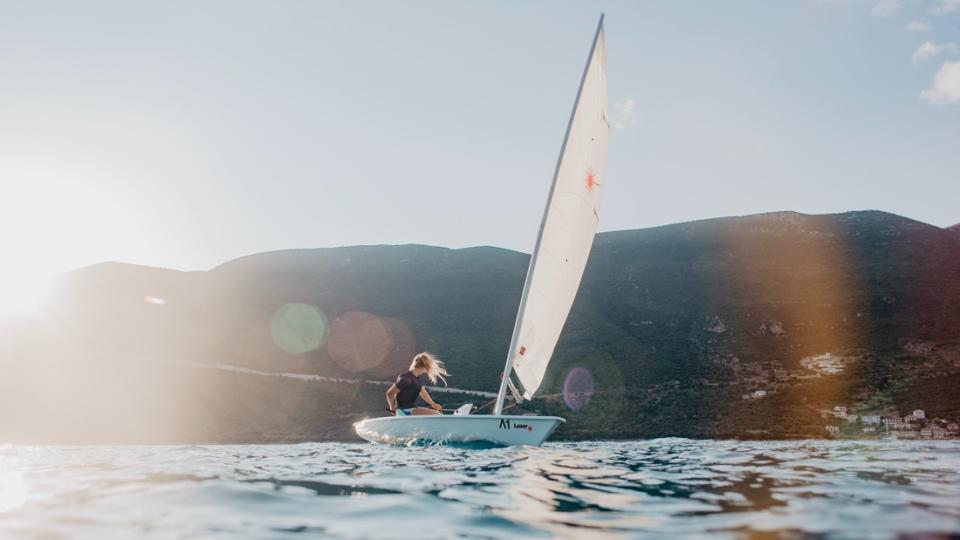This Clothing Brand Uses Ocean Plastic to Make Sustainable Activewear for Superyachts

- Oops!Something went wrong.Please try again later.
In 2016, 26-year-old Irishman Tom Cotter founded a small start-up with three of his school friends to produce eco-friendly rash vests. Within three years, the company had transformed into a global manufacturer of high-quality activewear and won the contract to supply Richard Branson’s Necker Island. The key to his success with OCEANR? Producing garments made from ocean plastic.
You need only look at the meteoric rise of Patagonia, a manufacturer of outdoor clothing known for its environmental efforts, to witness the global appetite for sustainable clothing. But in the past five years, the demand for garments made from ocean plastic has grown in gold rush-like proportions. Adidas, Stella McCartney, and Tom Ford, to name a few, have all put out luxury collections made from reclaimed marine plastic. With tens of thousands of crew working in superyachting—an industry that relies on the preservation of our oceans—it’s easy to see how the need for custom-designed eco apparel, such as Cotter’s OCEANR, has become something of a necessity.
More from Robb Report
“The turning point came in 2019 when the Australian Optimist Championships, which was promoting sustainability at the time, placed a large order,” says Cotter, who grew up in Cork, Ireland. “It significantly raised our profile and caught the attention of key yacht clubs.”

Since then, the company has gone on to supply activewear to many of the world’s top resorts, including Four Seasons and Velaa Private Island, as well as some of the largest superyachts on water, including 361-foot Kaos, 164-foot Endeavour, and 253-foot expedition yacht Legend. Its bespoke range of polo shirts, tech-tees, board-shorts, and safari hats, all made with recycled polyester and with UVF50+, are just what the crew of 289-foot Fountainhead deem necessary to protect them when working outdoors for long hours. Likewise, 240-foot Lunasea joined the growing raft of superyachts looking for customizable wet gear with eco-friendly credentials.
“We consider ourselves to be the sustainability specialists who operate at the active end of the yachting pipeline,” says Cotter, who first found an affinity with the sea during childhood family holidays to the Greek island of Lefkada. It paved the way for his interest in watersports, growing from pupil to instructor to budding environmentalist. During five years spent living in Melbourne, Australia, he managed the training and development department at the Royal Yacht Club of Victoria before becoming business development manager at Yachting Victoria.
“My original aim was to create the world’s first eco-friendly rash vest, then named RashR, but the core of the business goes far beyond that now,” he says. “We run a ‘return, repair, recycle’ scheme, whereby we repair any returned items that require it. We also shred any crew uniforms that are no longer needed and sell the shredded material to a car-seat manufacturer in Latvia, that uses it for stuffing.”
In 2022, OCEANR acquired the Latvian factory that manufactures its clothing, with the aim of creating a center of manufacturing excellence and sustainability in Europe. Cotter also facilitates and participates in regular beach clean ups—the most recent held in Kefalonia, Greece—and endeavors to support the companies he partners with to become more sustainable, whether that’s reducing their carbon footprint or learning responsible consumption practices.

One such partner, a social start-up called Enaleia, works with 700 fishermen in 13 ports throughout Greece and Italy, cash-incentivizing them to collect plastic instead of fish. It seems to be working, with more than 8,000 pounds of plastic collected from the bottom of the sea every week.
Cotter is proud of his company’s achievements, which has recovered over 1 million plastic bottles from the sea to date and claims to remove two pounds of ocean waste with every purchase. But he is equally candid about its limitations. “Our clothing is not fully ocean plastic, and I don’t think anyone can claim to be,” he says. “Ocean waste is so contaminated and degraded that it’s too low quality to use independently.”
OCEANR’s ‘Oceanbalance’ materials comprise around 5 percent ocean plastic. The remaining 95 percent is supplemented with recycled polyester (mostly from plastic bottles), GOTS-certified organic cotton, and pineapple leaf fibers (Piñatex) as a sustainable alternative to leather.
The company made headlines last year for winning the BITA Green Business Award thanks to its focus on environmental issues, and Cotter remains ambitious about where OCEANR is headed: “We’re not closed loop production yet, but we’re getting there.”
Best of Robb Report
The Ultimate Miami Spa Guide: 15 Luxurious Places to Treat Yourself
The 7 Most Insanely Luxurious Spas in the World, From Tokyo to Iceland
17 Reasons the Caribbean Should Be at the Top of Your Travel Itinerary
Sign up for Robb Report's Newsletter. For the latest news, follow us on Facebook, Twitter, and Instagram.

